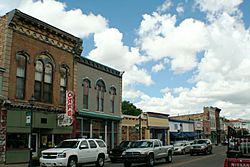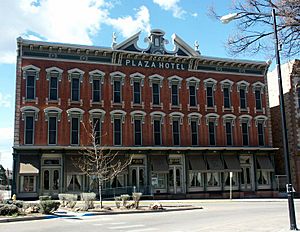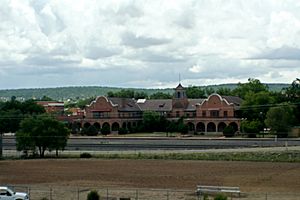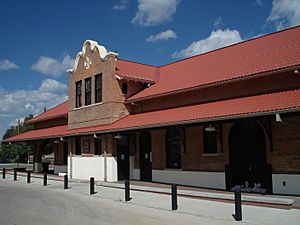Las Vegas, New Mexico facts for kids
Quick facts for kids
Las Vegas, New Mexico
|
|
|---|---|

Old Town Las Vegas, New Mexico
|
|

Location of Las Vegas, New Mexico
|
|
| Country | United States |
| State | New Mexico |
| County | San Miguel |
| Government | |
| • Type | Mayor-council government |
| Area | |
| • Total | 7.83 sq mi (20.27 km2) |
| • Land | 7.82 sq mi (20.26 km2) |
| • Water | 0.00 sq mi (0.01 km2) |
| Elevation | 6,424 ft (1,958 m) |
| Population
(2010)
|
|
| • Total | 13,753 |
| • Estimate
(2019)
|
12,919 |
| • Density | 1,651.41/sq mi (637.61/km2) |
| Time zone | UTC−07:00 (Mountain (MST)) |
| • Summer (DST) | UTC−06:00 (MDT) |
| ZIP Codes |
87701, 87745
|
| Area code(s) | 505 |
| FIPS code | 35-39940 |
| GNIS feature ID | 0915788 |
| Website | lasvegasnm.gov |
Las Vegas is a city in and the county seat of San Miguel County, New Mexico, United States. Once two separate municipalities (one a city and the other a town), both were named Las Vegas—West Las Vegas ("Old Town") and East Las Vegas ("New Town"); they are separated by the Gallinas River and retain distinct characters and separate, rival school districts.
The population was 13,753 at the 2010 census. Las Vegas is located 110 miles (180 km) south of Raton, 65 miles (105 km) east of Santa Fe, 122 miles (196 km) northeast of Albuquerque, 257 miles (414 km) south of Colorado Springs, Colorado, and 326 miles (525 km) south of Denver.
Contents
History

Las Vegas was established in 1835 after a group of settlers received a land grant from the Mexican government. The town was laid out in the traditional Spanish Colonial style, with a central plaza surrounded by buildings which could serve as fortifications in case of attack. Las Vegas soon prospered as a stop on the Santa Fe Trail. During the Mexican-American War in 1846, Stephen W. Kearny delivered an address at the Plaza of Las Vegas claiming New Mexico for the United States. In 1877 Las Vegas College, the precursor to Regis University, was founded in Las Vegas by a group of exiled Italian Jesuits. In 1887, Las Vegas College moved to Denver whereupon the name was changed.
A railroad was constructed to the town in 1880. To maintain control of development rights, it established a station and related development one mile (1.6 km) east of the Plaza, creating a separate, rival New Town, as occurred elsewhere in the Old West. The same competing development occurred in Albuquerque, for instance. During the railroad era Las Vegas boomed, quickly becoming one of the largest cities in the American Southwest. Turn-of-the-century Las Vegas featured all the modern amenities, including an electric street railway, the "Duncan Opera House" at the northeast corner of 6th Street and Douglas Avenue, a Carnegie library, the Hotel Castaneda (a major Harvey House), and the New Mexico Normal School (now New Mexico Highlands University). Since the decline and restructuring of the railroad industry began in the 1950s, the city's population has remained relatively constant. Although the two towns have been combined, separate school districts have been maintained (Las Vegas City Schools and West Las Vegas School District).
The anti-colonist organization Las Gorras Blancas was active in the area in the 1890s.
Cowboy Reunions
The first billed Cowboy Reunions were held once a year within 1915 until 1931. These reunions were meant to celebrate the ranching life that took place in northern New Mexico in the late 1800s. These reunions consisted of fair like activities, including pie eating contests, barbecues, and parades. They brought the working cowhand and celebrities of Rodeos together in the town of Las Vegas. The Cowboy Reunions reflected the occupations of the area.
Outlaws
The arrival of the railroad on July 4, 1879 brought with it businesses, development and new residents, both respectable and dubious. Murderers, robbers, thieves, gamblers, gunmen, swindlers, vagrants, and tramps poured in, transforming the eastern side of the settlement into a virtually lawless brawl. Among the notorious characters were such legends of the Old West as: dentist Doc Holliday and his girlfriend Big Nose Kate, Jesse James, Billy the Kid, Wyatt Earp, Mysterious Dave Mather, Hoodoo Brown, and Handsome Harry the Dancehall Rustler.
Historian Ralph Emerson Twitchell once claimed regarding the Old West, "Without exception there was no town which harbored a more disreputable gang of desperadoes and outlaws than did Las Vegas."
Geography
According to the United States Census Bureau, the city has a total area of 7.5 square miles (19 km2), all of it land.
Climate
| Climate data for Las Vegas, New Mexico. (Elevation 6,450ft) | |||||||||||||
|---|---|---|---|---|---|---|---|---|---|---|---|---|---|
| Month | Jan | Feb | Mar | Apr | May | Jun | Jul | Aug | Sep | Oct | Nov | Dec | Year |
| Record high °F (°C) | 72 (22) |
74 (23) |
81 (27) |
85 (29) |
95 (35) |
99 (37) |
98 (37) |
94 (34) |
94 (34) |
86 (30) |
80 (27) |
73 (23) |
99 (37) |
| Average high °F (°C) | 45.6 (7.6) |
48.7 (9.3) |
54.5 (12.5) |
62.8 (17.1) |
71.5 (21.9) |
80.9 (27.2) |
83.4 (28.6) |
81.0 (27.2) |
75.4 (24.1) |
66.3 (19.1) |
54.2 (12.3) |
46.8 (8.2) |
64.3 (17.9) |
| Average low °F (°C) | 18.4 (−7.6) |
20.8 (−6.2) |
25.2 (−3.8) |
32.5 (0.3) |
41.1 (5.1) |
49.6 (9.8) |
54.1 (12.3) |
52.8 (11.6) |
46.5 (8.1) |
36.4 (2.4) |
25.6 (−3.6) |
19.5 (−6.9) |
35.2 (1.8) |
| Record low °F (°C) | −26 (−32) |
−23 (−31) |
−16 (−27) |
−2 (−19) |
17 (−8) |
32 (0) |
37 (3) |
39 (4) |
23 (−5) |
3 (−16) |
−12 (−24) |
−14 (−26) |
−26 (−32) |
| Average precipitation inches (mm) | 0.32 (8.1) |
0.36 (9.1) |
0.61 (15) |
0.85 (22) |
1.58 (40) |
1.85 (47) |
3.05 (77) |
3.42 (87) |
1.86 (47) |
1.17 (30) |
0.59 (15) |
0.51 (13) |
16.18 (411) |
| Average snowfall inches (cm) | 6.4 (16) |
6.1 (15) |
6.9 (18) |
4.1 (10) |
0.6 (1.5) |
0.1 (0.25) |
0 (0) |
0 (0) |
0 (0) |
1.8 (4.6) |
4.4 (11) |
7.4 (19) |
37.7 (96) |
| Source: The Western Regional Climate Center | |||||||||||||
Demographics
| Historical population | |||
|---|---|---|---|
| Census | Pop. | %± | |
| 1890 | 2,312 | — | |
| 1900 | 3,552 | 53.6% | |
| 1910 | 3,755 | 5.7% | |
| 1920 | 4,304 | 14.6% | |
| 1930 | 4,719 | 9.6% | |
| 1940 | 5,941 | 25.9% | |
| 1950 | 7,494 | 26.1% | |
| 1960 | 7,790 | 3.9% | |
| 1970 | 7,528 | −3.4% | |
| 1980 | 14,322 | 90.2% | |
| 1990 | 14,753 | 3.0% | |
| 2000 | 14,565 | −1.3% | |
| 2010 | 13,753 | −5.6% | |
| 2019 (est.) | 12,919 | −6.1% | |
| U.S. Decennial Census | |||
As of the census of 2000, there were 14,565 people, 5,588 households, and 3,559 families residing in the city. The population density was 1,938.2 people per square mile (748.8/km2). There were 6,366 housing units at an average density of 847.1 per square mile (327.3/km2). The racial makeup of the city was 54.21% White, 0.99% African American, 1.96% Native American, 0.61% Asian, 0.10% Pacific Islander, 37.19% from other races, and 4.95% from two or more races. Hispanic people of any race were 82.94% of the population.
As noted in the chart to the right, the population of Las Vegas peaked at 14,753 in 1990. By 2019, the estimated population had decreased 12.43% to 12,919.
There were 5,588 households, out of which 33.0% had children under the age of 18 living with them, 36.0% were married couples living together, 21.2% had a female householder with no husband present, and 36.3% were non-families. 30.4% of all households were made up of individuals, and 9.7% had someone living alone who was 65 years of age or older. The average household size was 2.48 and the average family size was 3.08.
In the city the population was spread out, with 26.4% under the age of 18, 13.3% from 18 to 24, 26.2% from 25 to 44, 21.2% from 45 to 64, and 12.8% who were 65 years of age or older. The median age was 34 years. For every 100 females, there were 90.4 males. For every 100 females age 18 and over, there were 86.2 males.
The median income in 2019 for a household in the city was $26,561 as compared to the New Mexico median income of $49,754 and the national median of $62,843. The median income for a family in Las Vegas was $29,797. Males had a median income of $26,319 versus $21,731 for females. The per capita income for the city was $20.080 as compared to $34,103 nationally as noted in the 2019 Census estimate. In the past, 24.3% of families and 27.8% of the population were below the poverty line, including 35.7% of those under age 18 and 20.1% of those age 65 or over. The most recent figures (2019) as provided by the U. S. Census Bureau estimate the total number of persons (all ages) at or below the poverty line has increased to 35.6%. This is significantly higher than the national average of 10.5% and the State average of 18.2%.
Libraries and museums

The New Mexico Highlands University is home to the Thomas C. Donnelly Library. It supports the teaching, research and community activities of New Mexico Highlands University. It acquires, organizes, preserves and provides access to pertinent information and scholarly materials for curricular needs, intellectual pursuits and personal enrichment of its clientele. It promotes programs and services that emphasize the diversity of the university’s multicultural community and heritage. An addition increased the square footage from 23,700 to 53,500 and now holds a book collection of almost 200,000 volumes.
Las Vegas' Carnegie Library, established in 1904, is the only surviving Carnegie Library in New Mexico. Built from a $10,000 donation from philanthropist Andrew Carnegie, its Neo-Classical Revival architecture resembles Thomas Jefferson's Monticello. The library sits in the middle of a park that occupies an entire city block, bordered by Victorian-style homes and buildings.
The City of Las Vegas Museum & Rough Rider Memorial on Grand Avenue, dedicated in 1940, was first established by the decision of Theodore Roosevelt's Rough Riders regiment (the first Volunteer Cavalry Regiment of the Spanish–American War), who named Las Vegas its official reunion home. Their first reunion was held in Las Vegas, June 1899.
The museum, free and open to the public, houses a memorial collection of artifacts, archives and photographs from the Rough Riders and mementos in relation to the 1898 Cuban Campaign of the Spanish–American War, with information on over 200 members of the original regiment, RRR Association documents, etc. The museum illuminates the history of Las Vegas, its connection to the Rough Riders, the Santa Fe Trail and the development of New Mexico. It features collections of local Native American pottery, household items, costumes, ranching and farming equipment, agricultural and mercantile operations, and home life.
Housed in a 1940 Works Progress Administration-funded building, the museum is built of stone, with Pueblo Revival nuances.
Architecture

Las Vegas has numerous historic structures (mostly railroad-era houses and commercial buildings), with over 900 listed on the National Register of Historic Places. Although many buildings are in varying states of deterioration, others have been restored or are awaiting restoration. Some of the city's notable buildings include:
- Dr. H.J. Mueller House, now a Bed and Breakfast called Crow's Nest Bed and Breakfast. An 1881 example of Victorian eclecticism with unusual octagonal tower
- Plaza Hotel, 1881, site of the first reunion of Teddy Roosevelt's Rough Riders in 1899
- Old City Hall, New Mexico's first municipal building, completed in 1892
- Louis Fort House, Queen Anne house on Carnegie Park, built in 1895
- Masonic Temple, Richardsonian Romanesque building erected in 1895
- La Castaneda Hotel, mission-style Harvey House built in 1898
- Carnegie Library, built in 1903 at the center of Carnegie Park and modeled after Monticello
Transportation
Railway
- Las Vegas Amtrak Station is a stop on the Southwest Chief route.
Airport
- Las Vegas Municipal Airport serves single engine planes, small commercial jets, and helicopters.
Major highways
- Interstate 25
- Interstate 40 (55 miles to the south via U.S. Route 84)
Bus service
- None
Education
Public schools
The City of Las Vegas is served by two public school districts.
- Las Vegas City Schools serves the east side of Las Vegas.
- West Las Vegas School District serves the west side of Las Vegas.
The City of Las Vegas has two major high schools:
- Robertson High School
- West Las Vegas High School
Colleges
Las Vegas is the home of New Mexico Highlands University, an important university in New Mexico especially for teacher training. Highlands has long had an excellent science, drama, art, and foreign language faculty. The art department was nationally renowned in the 1950s to 1970s and beyond. Also nearby, north of Las Vegas, is Luna Community College. The United World College in nearby Montezuma, New Mexico is a two-year international high school and one of the venues used by the International Baccalaureate Program for teacher training in the United States.
Notable people
- Antonia Apodaca (1923-2020), musician
- S. Omar Barker (1894–1985), oft-recited cowboy poet; born in a log cabin in New Mexico, where he lived his entire life as a rancher, legislator, WW1 veteran, teacher and writer
- Margaret Herrera Chávez (1912–1992), painter
- Ann Nolan Clark (1896–1995), teacher in public schools and reservations, writer of children's multicultural books
- Teresa Leger Fernandez (born 1959), attorney, member of the U.S. House of Representatives (current)
- Wally Funk (born 1939), aviator, astronaut, and Goodwill Ambassador
- Fabiola Cabeza de Baca Gilbert (1894–1991), educator, nutritionist, activist, writer, inventor of the u-shaped fried taco shell
- Pelham D. Glassford (1883–1959), U.S. Army brigadier general
- Eddie Guerrero (1967–2005), professional wrestler for WWE, wrestled for New Mexico Highlands University
- Edgar Lee Hewett (1865-1946), archaeologist and anthropologist, founder of the Museum of New Mexico and first president of the New Mexico Normal School (now New Mexico Highlands University)
- Mari-Luci Jaramillo (1928–2019), educator and U.S. Ambassador to Honduras under Jimmy Carter
- Andrieus A. Jones (1862–1927), school principal and attorney, mayor of Las Vegas (1893–1894), United States Senator (1917–1927)
- Margaret Larkin (1899–1967), writer and musician; born in Las Vegas
- Ray Leger (1925–2009), educator and member of the New Mexico Senate
- Pola Lopez (born 1954), artist
- George J. Maloof Sr. (1923–1980), heir and businessman; born in Las Vegas
- Frank Olmstead (1923–2004), mayor of Las Vegas and 18th Auditor of New Mexico
- Patrick Swayze (1952–2009), actor, dancer and singer-songwriter; owned a ranch near Las Vegas
Images for kids
-
The Plaza Hotel, built in 1881, on the Plaza of West Las Vegas
See also
 In Spanish: Las Vegas (Nuevo México) para niños
In Spanish: Las Vegas (Nuevo México) para niños




